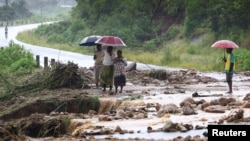Officials say Tropical Cyclone Freddy, one of the longest lasting tropical storms on record, has killed more than 350 people in southeastern Africa and displaced tens of thousands of others before dissipating over land Wednesday.
Malawi’s disaster management agency said Thursday at least 326 people died as the result of flooding and landslides generated by the storm. President Lazarus Chakwera declared a 14-day period of national mourning Wednesday, calling it a national tragedy and appealing for international support.
In neighboring Mozambique, where at least 53 deaths have been reported, officials also fear the death toll may rise as some villages have been completely cut off since the cyclone struck the nation a second time last week.
The level of devastation is attributed to the storm's longevity.
The U.N.’s World Meteorological Organization (WMO) said Freddy became a named storm February 6 in the Indian Ocean off the coast of Australia. It traveled across the entire ocean and made landfall in Madagascar February 21. It swept over the island nation, crossed the Mozambique Channel and initially hit Mozambique February 24.
The WMO said the storm then returned to the Indian Ocean, where it strengthened significantly over the warm water. Freddy then reversed course to return with much more power, including wind gusts of up to 200 kilometers per hour.
While no longer a tropical storm, the remnants of Freddy continue to bring rain to the region, along with the threat of additional flooding and landslides over the next few days.
The U.S. space agency NASA said Freddy has set the record for the highest accumulated cyclone energy – or ACE – of any southern hemisphere storm in history. ACE is an index used to measure the total amount of wind energy associated with a tropical cyclone over its lifetime.
The WMO said it is assembling a panel of experts to examine data to determine if Freddy has indeed set a record as the longest-duration tropical cyclone. The current record of 31 days was established by Hurricane/Typhoon John in 1994.
Some information for this report came from The Associated Press, Reuters and Agence France-Presse.











